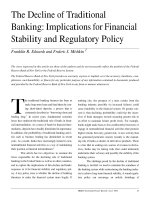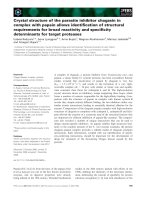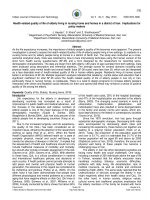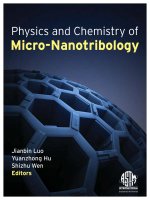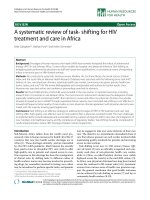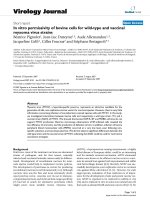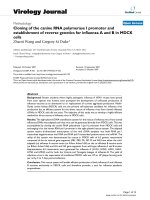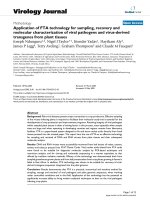Mineral chemistry of igneous rocks in the Lar Cu-Mo prospect, southeastern part of Iran: implications for P, T, and ƒO2
Bạn đang xem bản rút gọn của tài liệu. Xem và tải ngay bản đầy đủ của tài liệu tại đây (9.7 MB, 16 trang )
Turkish Journal of Earth Sciences
Turkish J Earth Sci
(2016) 25: 418-433
© TÜBİTAK
doi:10.3906/yer-1510-5
/>
Research Article
Mineral chemistry of igneous rocks in the Lar Cu-Mo prospect, southeastern part of
Iran: implications for P, T, and ƒO2
1,
1
1
2
Rahele MORADI *, Mohammad BOOMERI , Sasan BAGHERI , Kazuo NAKASHIMA
Department of Geology, Faculty of Sciences, University of Sistan and Baluchestan, Zahedan, Iran
2
Department of Earth and Environmental Sciences, Faculty of Science, Yamagata University, Yamagata, Japan
1
Received: 05.10.2015
Accepted/Published Online: 07.06.2016
Final Version: 24.10.2016
Abstract: The Lar Cu-Mo prospect is located 20 km north of Zahedan in Sistan and Baluchestan Province. This area is geologically
situated in the Sistan Suture Zone. The Cu-Mo mineralization occurs as silicic veins in the Lar igneous rocks and includes hypogene
chalcopyrite, bornite, and molybdenite mineralization. The syenite to monzonite host rocks occur as stock and dyke and display
granular to porphyritic texture. In this study, mineral chemistry and petrographic examination of igneous rocks are used to constrain
the crystallization conditions of the magma. The compositional range of plagioclase is relatively narrow (0.11%–26.05% An), whereas
that of potassium feldspar is wide (11.80%–96.02% Or). Analyses of representative Lar biotite samples with electron microprobe
analysis suggest that crystallization took place at average temperature of 731 °C. Amphiboles are calcic and compositionally range
from pargasite to ferro-pargasite, edenite, actinolite, and magnesio-hornblende. Estimation of temperature and pressure using calcic
amphibole geothermobarometry equations indicates that crystallization is estimated to have taken place at 831 °C and 7.65 kbar.
Clinopyroxenes are mainly diopside and were crystallized in a magma chamber at an average temperature and pressure of 926 °C and
7.54 kbar, respectively. According to the mineral composition, the studied igneous rocks are calc-alkaline in magmatic series and were
crystallized from a calc-alkaline oxidized magma. The whole-rock chemical data show that the study rocks are shoshonitic and high-K
calc-alkaline.
Key words: Mineral chemistry, syenite, Cu-Mo mineralization, Lar, Sistan Suture Zone, southeastern part of Iran
1. Introduction
The Lar Cu-Mo prospect located 22 km north of
Zahedan, southeast Iran, at the border with Pakistan and
Afghanistan is proximal to Saindak and the giant Reko Diq
copper deposits of Pakistan (Figure 1a). The Lar Cu-Mo
prospect mainly occurs in syenitic to monzonitic igneous
rocks of the Lar igneous complex (LIC). Although the LIC
has been subject of several petrological and geochemical
studies (Chance, 1981; Bagheri and Bakhshi, 2001; Nakisa,
2002; Karimi, 2002; Boomeri, 2004; Ghafari-Bijar, 2009;
Farokh-Nezhad, 2011; Soltanian, 2013), the host rock
characteristics of the Lar Cu-Mo prospect were the subject
of few studies (Karimi, 2002; Nakisa, 2002; Dushangani,
2015). The Lar Cu-Mo prospect has been explored and
drilled by the National Iranian Copper Industries Co.
(Nakisa, 2002). The mineralization covers an area of 0.75
km2 and contains several million tons of mineralized
rocks averaging 0.2% Cu and 0.01% Mo (Nakisa, 2002;
Dushangani, 2015). Although the mineralization
is considered as a subeconomical mineralization
*Correspondence:
418
(Dushangani, 2015), infill drilling to a nominal 250 m led
to understand that the mineralization continues in deeper
depths.
In general, the chemical compositions of minerals
provide valuable information on the origin and nature
and postsolidus modifications of the magmas, as well as
the nature of the ore fluids associated with the magmas
(Imai, 2000; Boomeri et al., 2009, 2010; Xianwu et al.,
2009; Siahcheshm et al., 2012; Einali et al., 2014). Studying
the chemistry of mineral assemblages and compositions of
igneous rocks can assist in understanding the temperature,
pressure, and fugacity ratios of a magma process (Idrus et
al., 2007; Panigrahi et al., 2008; Einali et al., 2014).
Chemical compositions of rock-forming minerals in
the Lar Cu-Mo prospect igneous rocks have not yet been
determined. In this study, we present data on the mineral
chemistry of primary minerals in igneous host rocks
from the Lar Cu-Mo prospect. With data obtained from
these minerals and by employing geothermobarometric
methods, pressure, temperature, and oxygen fugacity
MORADI et al. / Turkish J Earth Sci
Figure 1. Geological maps of the a) main tectonostratigraphic units of Iran (Stöcklin, 1968), b) geological subdivisions of the SSZ and its principal
igneous rock units (modified from Camp and Griffis, 1982; Tirrul et al., 1983). Faults are: BF, Bandan fault; EN, East Neh fault; WN, West Neh fault; ZF,
Zahedan fault; KF, Kahurak Fault. Place names are: Sefidabeh (S), Nosratabad (NO). Intrusions are: Zahedan granites (ZG), Lar igneous complex (LIC),
Kuh-e Malek Siah (KM), Kuh-e Seyasteragi (KS), Kuh-e Assagie (KA), Kuh-e Janja (KJ), Zahedan-Nehbandan magmatic belt (ZNMB). c) Geological
maps of the Lar area (based on Behrouzi, 1993).
419
MORADI et al. / Turkish J Earth Sci
values were calculated. All these helped constrain the
crystallization conditions and evolutions of the Lar CuMo prospect.
2.Geology
The study area is located in the N–S trending 700-kmlong Sistan Suture Zone (SSZ) (Figures 1a and b) that
extends from Iran to Afghanistan and Pakistan. The
SSZ is considered to have been a remnant of the late
Cretaceous oceanic basin as a branch of the Neotethys.
The SSZ was divided into the Neh-Ratuk accretionary
prism and the Sefidabeh forearc basin (Figure 1b). Based
on Camp and Griffis (1982) and Tirrul et al. (1983), the
SSZ is characterized by the following features: A) the
presence of Late Cretaceous ophiolites that are the oldest
igneous rocks of this area and are the remnants of the
Sistan oceanic crust between the Lut and Sistan blocks;
B) flysch-type rocks that are the most dominant rocks
in the SSZ and composed of Cretaceous to Paleocene
sedimentary, metasedimentary, and siliceous clastic rocks;
and C) nonophiolitic igneous rocks that are different in
age, composition, and genesis and can be divided based
on their age as follows: 1) Eocene calc-alkaline rocks of the
accretionary prism that are related to subduction events
in the area (Camp and Griffis, 1982); 2) Late Eocene
Zahedan calc-alkaline I, rare S, and hybrid-type granitoids
that are related to subduction and collision events in the
area (Camp and Griffis, 1982; Sahebzadeh, 1996; Hosseini,
2002; Boomeri et al., 2005; Kord, 2005; Sadeghian, 2005;
Sadeghian et al., 2005; Sadeghian and Valizadeh, 2007;
Rahnama-Rad et al., 2008; Ghasemi et al., 2010; Moradi
et al., 2014); 3) Oligocene to Middle Miocene alkaline and
calc-alkaline igneous rocks of the Zahedan-Nehbandan
narrow magmatic belt (ZNMB) (Camp and Griffis, 1982)
(Figure 1b), where the alkaline magmatism is closely
related to major transcurrent faults, which were important
postcollisional structural features (Camp and Griffis,
1982); 4) Quaternary volcanic rocks like Mount Taftan
that are related to the Makran active subduction of the
Oman oceanic lithosphere under the Makran accretionary
prism and the SSZ (Farhoudi and Karig, 1977). Although
subduction, collision, and postcollisional events in the
SSZ were confirmed by the majority of researchers, the
mechanism and timing of the opening and closing of
the oceanic basin has been differently discussed, i.e.
subduction of the SSZ beneath the Afghan block (Camp
and Griffis, 1982; Tirrul et al., 1983), subduction of the SSZ
beneath the Lut block (Zarrinkoub et al., 2012), two-sided
subduction of the SSZ beneath the Afghan and Lut blocks
(Arjmandzadeh et al., 2011), and intraoceanic subduction
by the east (Saccani et al., 2010).
The Lar Cu-Mo prospect in the west and southwest
of the LIC is a part of the ZNMB at the southeastern
420
extension of the SSZ (Figure 1b). The ZNMB is composed
of alkaline, shoshonitic, and calc-alkaline extrusive and
intrusive units where country rocks are represented by
the flysch that accumulated in the accretionary prism
setting. A number of igneous rocks were identified in the
ZNMB such as the LIC and Malek Siah, Seyasteragi, and
Janja intrusions and Assagie volcanic mountain. Pang et
al. (2013) investigated igneous rocks in the north part
of the ZNMB where magmatism was active from the
middle Eocene (~46 Ma) to the late Oligocene (~25 Ma).
The igneous rocks are calc-alkaline, high-K calc-alkaline
(HKCA), and shoshonitic, triggered by convective removal
of the lithosphere and resultant asthenospheric upwelling
during postcollision extensional collapse of the SSZ in the
Eocene-Oligocene (Pang et al., 2013).
The LIC is a late Oligocene elliptical (about 40 km2
in size) igneous complex, hosted by flysch-type rocks of
the Sefidabeh forearc (Figure 1c). Its bigger diameter is
parallel to the Zahedan fault system in the western and
southwestern parts. The main body of the LIC includes gray
to dark-gray extrusive rocks such as lava and pyroclastic
breccias, which were intruded by stocks, subvolcanic ring
dykes, masses, and veins. The main igneous rocks of the
LIC consist of trachyte, trachyandesite, andesite, tuff,
volcanic breccia, hornblende-bearing porphyritic diorite,
syenite, monzonite, latite, and calc-alkali to shoshonitic
lamprophyres like minette, olivine minette, shonkinite,
spessartite, and vogesite, which have been formed from
shoshonitic and HKCA magmas (Chance, 1981; Bagheri
and Bakhshi, 2001; Ghafari-Bijar, 2009; Farokh-Nezhad,
2011; Soltanian, 2013). Structurally, there are at least two
main fault systems in the Lar Cu-Mo prospect with NWSE and NE-SW trends (Karimi, 2002). The NW-SE system
is mainly associated with mineralization and has been
displaced by the younger NE-SW system.
3.Mineralization and alteration
The Lar Cu-Mo prospect is situated in the western and
southwestern parts of the LIC (Figures 1a, 2a, 2b, and 3).
The northeastern and eastern parts of the mineralized area
consist of intermediate igneous rocks, and its southwestern
and western parts consist of flysch type rocks (Figure 2a).
The geology of the mineralized area consists of hornfels,
shale, volcanic rocks, and syenitic to monzonitic igneous
rocks. The flysch-type rocks such as siltstone and shale in
the eastern side of the mineralized area are moderately
to strongly recrystallized or metamorphosed to hornfels
due to contact metamorphism effects of the Lar igneous
rocks. The syenitic to monzonitic igneous rocks were also
intruded by microsyenitic veins, quartz alkali feldspars
syenite dykes, and silicic veins and veinlets (Figures 4a
and b). Large blocks of the hornfels and metavolcanic
rocks are common with syenitic to monzonitic igneous
MORADI et al. / Turkish J Earth Sci
Figure 2. a) Geological map of the Lar Cu-Mo prospect (modified from Kan Iran Engineering, 1999), b) map location of bore
holes with mineralized silicic veins in the Lar Cu-Mo prospect.
rocks, especially in the eastern side. The intrusive rocks
that outcrop in the mineralized area are pinkish in color
due to supergene alteration that obscures primary textures
and mineralogy, especially in the upper levels. The CuMo mineralization is primarily associated with silicic
veins and veinlets (Figure 4c) that occur within syenite
and monzonite and include chalcopyrite, bornite and
molybdenite, magnetite, and hematite as well as supergene
oxidation products of chalcocite, native copper, enargite,
limonite, malachite, and azurite (Figures 4d–4f).
Disseminated bornite and chalcopyrite only occur in
the host rocks that are near the silicic veins and veinlets.
The grades closely correlate with the density of the veins.
Generally, the mineralized veins and veinlets show low
density across the study area. Therefore, the host rocks
mainly contain minor or no amounts of the mineralized
silicic veins or veinlets.
The alteration zones in the study area are not regular
and pervasive. They are often associated with tectonized
locations, and they are more intense in the direction of the
main faulted and fractured zones. Therefore, the fractures
and faults play a significant role in the control of alteration
and mineralization focus. As the main primary mineral of
the host rocks is orthoclase, it is difficult to characterize
the potassic alteration. This alteration type is characterized
by the veins containing biotite and potassium feldspar
associated with bornite, chalcopyrite, and/or molybdenite.
It seems that some plagioclase was replaced by potassium
421
MORADI et al. / Turkish J Earth Sci
Figure 3. Field photograph of the Lar igneous complex and the Lar Cu-Mo mineralized area.
Figure 4. Field photographs of a) microsyenite vein in the porphyry syenite, b) quartz alkali feldspars syenite dyke, c) mineralized
silicic vein, d) dispersed ore minerals in syenite. Photomicrographs of e) the same paragenesis of chalcocite, bornite, and
chalcopyrite; f) molybdenite. Bn: Bornite, Cct: chalcocite, Ccp: chalcopyrite, Cv: covellite, Mol: molybdenite.
feldspar. Propylitic alteration is more widespread in
peripheral parts of the mineralized area, especially in the
hornfels and metavolcanic rocks. Epidote, calcite, chlorite,
and minor sericite partially replaced magmatic pyroxene,
hornblende, and biotite. Minor actinolite forms along the
cleavage of the primary amphibole in a few samples. There
are no distinct alteration zones of the phyllic and argillic
in the studied parts of the mineralized area. However,
422
the majority of the feldspars are partially replaced by
sericite and clay minerals. Pyrite is a rare mineral in the
mineralized area. The quartz veins and veinlets that are
the most prominent character of the mineralized area may
not be related to the phyllic alteration. Argillic alteration
locally occurs in outcrops and shallow depths. This
alteration type, which is characterized by clay minerals,
iron hydroxide, and Cu carbonates, was probably formed
by supergene processes.
MORADI et al. / Turkish J Earth Sci
4. Materials and methods
One hundred samples were collected from fresh and
mineralized rocks from the surface and drill holes.
The samples were examined by polarized microscope
for petrographic and mineralographic descriptions at
the University of Sistan and Baluchestan. Twelve thinpolished sections were chosen from less-altered syenitic to
monzonitic igneous rocks with granular and porphyritic
textures and tuff for electron microprobe analysis in order
to determine their mineral composition.
In general, there are several generations of minerals
in the Lar Cu-Mo prospect, but our analyzed minerals are
magmatic feldspars, biotite, amphibole, and clinopyroxene.
The selected magmatic minerals are commonly euhedral
and subhedral in shape and show no evidence of having
been replaced. Their modal percentages are based on
visual estimates.
These minerals were analyzed by the automated
JEOL JXA-8600 superprobe of Yamagata University with
accelerating voltage of 15 kV, a beam current of 20 nA, a
beam diameter of about 5 µm, detection limits of 0.05 wt.
%, and a maximum 40-s counting interval. The diameter
of the focused electron beam is about 5 µm. Data were
processed by an online computer using the oxide ZAF in
the XM-86 PAC program of JEOL. Calibration standards
for the mentioned minerals were apatite, wollastonite,
albite, adularia, synthetic SiO2, TiO2, Al2O3, Fe2O3, MnO,
MgO, CaF2, and NaCl. In each sample, several grains and
several points of each mineral were analyzed based on
textural relations, and an average of the analytical results
was taken to represent the typical composition of that
mineral in each sample. Formula calculations of feldspar,
biotite, amphibole, and pyroxene are based on 32, 22,
23, and 6 atoms of oxygen, respectively. The amphiboles’
ferric/ferrous ratios were calculated using 15-cation
normalization and charge balance. The magmatic minerals
in the granular syenitic rocks were used for employing
geothermobarometric methods in order to determine
crystallization conditions because these samples were not
affected by weathering, overprinting, and late granodioritic
veinlets.
5. Petrography
The dominant igneous rocks in the Lar Cu-Mo mineralized
area are syenite and monzonite with lesser amounts of
granodiorite and pyroclastic rocks. Syenite is dominantly
medium- to coarse-grained, porphyritic, granular, and
occasionally cataclastic in texture. There is extreme
variation in the ratio of phenocrysts to groundmass. The
groundmass ratio is less than 30% in porphyritic syenite
and monzonite. The syenite is composed of plagioclase,
clinopyroxene, and potassium feldspar as main minerals
that crystallized at first and were followed by amphiboles,
biotite, and Fe-Ti oxides. A second generation of feldspars
and biotite can also be observed in some syenitic rock
types. Moreover, sphene, apatite, zircon, and magnetite are
common accessory minerals.
Orthoclase is the most abundant mineral in the syenite
occurring as phenocrysts (Figure 5a) and groundmass.
The orthoclase phenocrysts are euhedral to subhedral and
up to 4 cm in size. Some of the phenocrysts of orthoclase
poikilitically contain inclusions of biotite, titanite, apatite,
pyroxene, and opaque minerals. The plagioclase is lathshaped, euhedral to subhedral, and shows polysynthetic
twinning (Figure 5b).
The biotite occurs as phenocryst (Figure 5c), tiny
crystals in the groundmass, inclusions in the other
minerals, and also secondary hydrothermal phases.
Under the microscope, the biotite phenocrysts are mainly
brown in color (in plane polarized light), variable in size,
sometimes showing kink band twinning, with deformed
cleavage, and have inclusions of apatite, titanite, and
opaque minerals.
The amphibole occurs as phenocrysts and tiny crystals
in shape, green in color (in plane polarized light), and
variable in size (Figure 5d). Based on petrographic studies,
the amphiboles mainly belong to the primary hornblende
group and secondary actinolite. Clinopyroxene is the
other ferromagnesian mineral in the Lar porphyry and
granular syenitic rocks. Based on microscopic studies,
greenish clinopyroxene occurs as subhedral to euhedral
crystals in both phenocrysts (Figure 5e) and groundmass
with variable size. The monzonite and syenite are
petrographically similar and show extreme variation in
the ratio of orthoclase to plagioclase. The monzonite has
higher proportions of plagioclase relative to syenite.
The volcanic rocks occurred as lava and pyroclastic
rocks. The volcanic rocks are mainly trachyte, latite, and
andesite in composition, porphyritic and trachytic in
texture, and gray and green in color. The phenocrysts are
about 50% of these rocks and composed of plagioclase,
potassium feldspar, amphiboles, biotite, and opaque
mineral. The groundmass is composed of fine-grained
crystals of feldspar and ferromagnesian minerals.
Plagioclase and potassium feldspar are variable in size (up
to 5 mm) and shape (euhedral to subhedral).
6. Mineral chemistry
6.1. Feldspar
Sixty-four points from six samples on feldspar phenocrysts
of porphyritic igneous rocks and 31 points from three
samples on granular igneous rocks were analyzed and
plotted on the ternary orthoclase-albite-anorthite
diagram of Deer et al. (1979) (Table 1; Figures 6 and 7).
The potassium feldspars in the igneous rocks belong
to sanidine-albite solid solutions in both porphyry and
423
MORADI et al. / Turkish J Earth Sci
Figure 5. Cross-polarized light photomicrographs of a) alkali feldspars, b) plagioclase, c) biotite, d) amphibole, e) clinopyroxene.
Kfs: Potassium feldspar, Pl: plagioclase, Bt: biotite, Amp: amphibole, Cpx: clinopyroxene.
granular igneous rocks (Figures 6 and 7). As petrographic
studies show that the potassium feldspars are orthoclase,
variation in Na contents is probably due to invisible
cryptoperthite and microperthite in low-temperature
feldspars (orthoclase and microcline) (MacKenzie and
Smith, 1955). The plagioclases are mostly albite in both
porphyry and granular rocks (Figures 6 and 7). Albite
is the most common plagioclase in the syenitic rocks.
Oligoclase and andesine belong to the late granodioritic
phase that intruded on the syenite rocks.
6.2. Biotite
Twenty-four points from five samples and 15 points from
three samples on biotite phenocrysts of porphyry and
granular igneous rocks were analyzed, respectively (Table
2). The biotite compositions, when referred to the Al
versus Fe/(Fe+Mg) (Rieder et al., 1998) diagram (Figure
8), clearly plot in the biotite field near the biotite and
phlogopite line boundary. The biotites are the primary
type (Figure 9), and they have a narrow range in chemical
composition as SiO2, Al2O3, TiO2, and MgO range from
38.01 to 39.16, from 14.44 to 15.39, from 3.23 to 3.74, and
from 14.74 to 15.50, respectively. It seems that the biotite
is Mg- and Ti-rich and F- and Cl-poor.
6.3. Amphibole
Sixteen points from two samples and 14 points from one
sample on amphibole phenocrysts of porphyry and granular
igneous rocks were analyzed, respectively (Table 3).
424
According to the classification of Leake et al. (1997), the
associated amphibole phenocrysts with mineralized area
are commonly calcic (pargasite to ferro-pargasite, edenite,
actinolite, and magnesio-hornblende; Figure 10) with igneous
nature (Figure 11).
In porphyry igneous rocks, amphiboles are chemically
edenite, actinolite, and magnesio-hornblende with a
high content of Mg and low content of Al and Ti. The
actinolites are mainly due to weathering and alteration
processes. According to Chivas (1981), amphiboles with
Si of 7.3 (apfu) or less are generally considered magmatic
and Si higher than 7.3 (apfu) is not a truly magmatic
amphibole. The average content of Na2O is higher than
K2O in amphiboles of both porphyry and granular igneous
rocks. Moreover, based on Al content, the amphiboles
can be also divided into two groups: low-Al amphiboles
(actinolite, edenite, and magnesio-hornblende) and highAl amphiboles (pargasite and ferro-pargasite) (Table 3).
6.4. Clinopyroxene
Four points from one sample on clinopyroxene phenocrysts
of porphyritic igneous rocks and 14 points from two
samples on granular igneous rocks were analyzed (Table
3). The representative Lar clinopyroxene analyses fall
within the field of calcic composition. The clinopyroxenes
have Al2O3 ranges from 2.58 to 3.25, and based on the
classification of Deer et al. (1979), they are of the diopside
type.
Porphyry
2
Av.
68.45
0.00
18.89
0.86
0.00
0.00
0.04
0.91
13.61
0.11
102.87
L44
Pl
3
7
Av.
73.79
0.02
20.86
0.15
0.00
0.01
0.54
7.07
0.36
0.02
102.82
Textures
Samples
Minerals
Number of grains
Number of points
SiO2 (wt. %)
TiO2
Al2O3
FeO
MnO
MgO
CaO
Na2O
K2O
BaO
Total
12.280
0.003
4.091
0.021
0.000
0.002
0.096
2.281
0.076
0.001
18.852
3.92
92.96
3.11
12.127
0.000
3.944
0.127
0.000
0.000
0.008
0.313
3.076
0.008
19.602
0.22
9.20
90.57
11.046
0.003
5.047
0.067
0.001
0.003
1.132
2.188
0.071
0.003
19.561
33.39
64.51
2.10
Av.
63.22
0.02
24.51
0.46
0.01
0.01
6.05
6.46
0.32
0.04
101.10
7
1
Pl
L18
12.280
0.001
3.930
0.010
0.001
0.000
0.004
0.118
2.915
0.014
19.279
0.12
3.90
95.98
Av.
70.36
0.01
19.10
0.07
0.01
0.00
0.02
0.35
13.09
0.20
103.21
4
1
Afs
12.317
0.001
4.118
0.010
0.000
0.007
0.098
2.013
0.128
0.001
18.695
4.39
89.90
5.71
Av.
73.77
0.01
20.93
0.07
0.00
0.03
0.55
6.22
0.60
0.02
102.20
7
2
Pl
L20
12.225
0.005
3.970
0.017
0.000
0.000
0.067
0.819
2.181
0.025
19.309
2.17
26.72
71.11
Av.
70.87
0.04
19.53
0.12
0.00
0.00
0.36
2.45
9.91
0.37
103.65
3
1
Afs
11.970
0.000
4.318
0.003
0.000
0.003
0.330
2.452
0.044
0.002
19.121
11.66
86.78
1.55
Av.
69.66
0.00
21.32
0.02
0.00
0.01
1.79
7.36
0.20
0.03
100.39
1
1
Pl
L79
Granular
Afs: Potassium feldspars, Pl: plagioclase, An: anorthite, Ab: albite, Or: orthoclase.
Si (apfu)
Ti
Al
Fe2+
Mn
Mg
Ca
Na
K
Ba
Total
An (mol %)
Ab
Or
Numbers of cations on the basis of 32 O
1
Afs
Syenite
Rocks
12.167
0.003
3.996
0.013
0.001
0.000
0.058
0.768
2.419
0.018
19.443
1.77
23.68
74.54
Av.
69.75
0.02
19.44
0.09
0.01
0.00
0.31
2.27
10.87
0.26
103.01
12
3
Afs
12.202
0.003
4.243
0.023
0.003
0.013
0.101
1.907
0.269
0.003
18.765
4.44
83.76
11.80
Av.
72.45
0.02
21.38
0.16
0.02
0.05
0.56
5.84
1.25
0.05
101.78
5
2
Pl
L2
12.047
0.001
4.108
0.018
0.001
0.000
0.107
0.671
2.562
0.010
19.524
3.18
20.07
76.74
Av.
68.92
0.01
19.94
0.12
0.01
0.00
0.57
1.98
11.49
0.14
103.17
3
1
Afs
11.954
0.003
4.300
0.010
0.003
0.003
0.358
2.353
0.176
0.001
19.159
12.40
81.52
6.08
Av.
71.22
0.02
21.74
0.07
0.02
0.01
1.99
7.23
0.82
0.02
103.14
4
1
Pl
L90
Table 1. Representative average chemical composition (wt. %) and structural formulae of feldspars in the Lar igneous rocks.
11.815
0.003
4.398
0.026
0.001
0.034
0.040
0.522
2.811
0.006
19.655
1.17
15.49
83.33
Av.
67.18
0.02
21.22
0.18
0.01
0.13
0.21
1.53
12.53
0.08
103.10
6
2
Afs
12.108
0.001
4.219
0.018
0.001
0.005
0.276
2.151
0.152
0.003
18.936
10.71
83.42
5.88
Av.
72.34
0.01
21.39
0.13
0.01
0.02
1.54
6.63
0.71
0.05
102.83
11
3
Pl
L15
12.293
0.003
3.965
0.007
0.001
0.000
0.009
0.117
2.771
0.012
19.178
0.32
3.99
95.69
Av.
71.47
0.02
19.56
0.05
0.01
0.00
0.05
0.35
12.63
0.18
104.31
3
1
Afs
Porphyry
Monzonite
12.328
0.001
4.060
0.007
0.001
0.000
0.084
2.296
0.023
0.002
18.802
3.48
95.52
1.00
Av.
74.22
0.01
20.74
0.05
0.01
0.00
0.47
7.13
0.11
0.03
102.78
8
3
Pl
L30
11.641
0.003
4.311
0.026
0.000
0.003
1.208
1.985
0.033
0.001
19.211
37.45
61.52
1.03
Av.
67.08
0.02
21.08
0.18
0.00
0.01
6.50
5.90
0.15
0.01
100.93
4
2
Pl
L57
11.804
0.005
4.335
0.089
0.003
0.011
0.019
0.511
3.005
0.044
19.826
0.52
14.43
85.04
Av.
65.79
0.04
20.50
0.59
0.02
0.04
0.10
1.47
13.13
0.63
102.30
8
3
Afs
Porphyry
Tuff
MORADI et al. / Turkish J Earth Sci
425
MORADI et al. / Turkish J Earth Sci
Figure 6. Classification of feldspars in the Lar Cu-Mo prospect porphyry igneous rocks on a ternary orthoclasealbite-anorthite diagram. Field boundaries from Deer et al. (1979).
biotite to obtain reliable temperature estimates in igneous
and metamorphic rocks (Luhr et al., 1984; Patino Douce,
1993). We used the empirical Ti/ Fe2+ geothermometer of
Luhr et al. (1984) to calculate plutonic biotite precipitation
temperatures in the granular igneous rocks with the
following equation:
Calculated temperatures for biotite from granular
syenitic rocks show an average temperature of 731 °C.
Amphibole thermometry for pargasites and ferropargasites in the Lar granular syenitic rocks was calibrated
according to the method of Ridolfi et al. (2010) with the
following equation:
Figure 7. Classification of feldspars in the Lar Cu-Mo prospect
granular igneous rocks on a ternary orthoclase-albite-anorthite
diagram. Field boundaries from Deer et al. (1979).
where
7. Crystallization conditions
7.1. Temperature
The concentration of Ti and the Ti/ Fe2+ ratio in biotite
are very sensitive to temperature, making it possible to use
426
The calculations suggest a mean temperature of 831 °C.
The electron microprobe analyses of pyroxene can
also be used in thermometry based on the method of
MORADI et al. / Turkish J Earth Sci
Table 2. Representative average chemical composition (wt. %) and structural formulae of biotite in the Lar igneous rocks.
Rocks
Syenite
Textures
Porphyry
Samples
L18
L20
L2
L12
L3
L15
L13
L57
Number of grains
2
1
1
2
2
1
2
2
Number of points
6
2
3
6
6
3
6
7
Av.
Av.
Av.
Av.
Av.
Av.
Av.
Av.
SiO2 (wt. %)
38.27
38.35
38.94
39.00
38.01
39.16
39.14
38.95
TiO2
3.55
3.68
3.70
3.48
3.66
3.44
3.44
3.23
Al2O3
15.16
14.70
15.09
14.44
15.30
14.51
14.73
15.39
FeO
16.41
16.88
15.96
16.07
16.87
16.83
15.86
16.05
MnO
0.20
0.21
0.28
0.24
0.26
0.20
0.31
0.24
MgO
15.10
14.95
14.94
15.33
14.75
14.74
15.14
15.58
CaO
0.03
0.05
0.03
0.05
0.03
0.14
0.07
0.04
Granular
Monzonite
Tuff
Porphyry
Porphyry
Na2O
0.12
0.14
0.15
0.12
0.18
0.11
0.13
0.23
K2O
9.14
8.16
9.30
8.88
9.33
8.65
8.92
8.55
BaO
0.08
0.26
0.10
0.12
0.10
0.10
0.16
0.22
Cl
0.09
0.08
0.06
0.13
0.07
0.13
0.08
0.03
F
0.31
0.21
0.28
0.23
0.22
0.39
0.41
0.23
Total
98.46
97.67
98.89
98.12
98.79
98.4
98.39
98.74
Numbers of cations on the basis of 22 O
5.551
5.598
5.610
5.657
5.519
5.671
5.655
5.600
IV
Si (apfu)
Al
2.449
2.402
2.390
2.343
2.481
2.329
2.345
2.400
T Site
8.000
8.000
8.000
8.000
8.000
8.000
8.000
8.000
VI
Al
0.144
0.128
0.173
0.127
0.138
0.149
0.164
0.209
Ti
0.387
0.404
0.401
0.380
0.400
0.375
0.374
0.349
Fe
1.991
2.061
1.923
1.950
2.049
2.038
1.916
1.930
Mn
0.025
0.026
0.034
0.029
0.032
0.025
0.038
0.029
Mg
3.264
3.253
3.208
3.314
3.192
3.181
3.260
3.338
O site
5.811
5.872
5.745
5.803
5.812
5.768
5.753
5.856
Ca
0.005
0.008
0.005
0.008
0.005
0.022
0.011
0.006
Na
0.034
0.040
0.042
0.034
0.051
0.031
0.036
0.064
K
1.691
1.520
1.709
1.643
1.728
1.598
1.644
1.568
Ba
0.005
0.015
0.006
0.007
0.006
0.006
0.009
0.012
A site
1.730
1.567
1.756
1.685
1.784
1.651
1.692
1.639
Cl
0.011
0.010
0.007
0.016
0.009
0.016
0.010
0.004
F
0.071
0.048
0.064
0.053
0.051
0.089
0.094
0.052
OH
3.918
3.942
3.929
3.931
3.941
3.895
3.897
3.944
XMg
0.621
0.612
0.610
0.630
0.634
T °C
0.625
0.630
0.609
742
726
726
OH is calculated by OH = 4 − (Cl + F); XMg = Mg / (Mg + Fe).
427
MORADI et al. / Turkish J Earth Sci
Figure 9. Chemical composition of biotite crystals using the
(FeO + MnO) – 10TiO2 – MgO ternary diagram (Nachit et al.,
2005). Similar symbols as in Figures 6 and 7.
Figure 8. Plot of Fe / (Fe + Mg) versus ΣAl showing the
classification of biotite. Field boundaries from Rieder et al.
(1998). Similar symbols as in Figures 6 and 7.
Dal Negro et al. (1982). They calculated the temperature
of crystallization for pyroxenes based on the following
equation:
Here,
and
Depending on this calculation, the clinopyroxene
average temperature from the granular syenitic rocks is
926 °C.
7.2. Pressure
The barometric method of Nimis (1999) was used for
pyroxene barometry with following equation:
Here,
and
The estimated pressure for pargasite and ferropargasite crystallization in the studied granular syenitic
rocks is about 7.65 kbar (R2 = 0.99). Although Al2O3
contents of the Lar pargasites and ferro-pargasites are high
and we can ascribe this to their crystallization at higher
pressures, in general Al in amphiboles increases with both
P and T, and compositional variations (high proportions
of melt) also seem to influence the partitioning of Al2O3
in Ca-amphibole (Ali, 2012). Since the parental magma of
the Lar Cu-Mo prospect igneous rocks is shoshonitic in
nature and high Al contents are one of the main characters
of this kind of magma, the high Al contents in the studied
amphiboles depend on Al contents in the melt.
7.3. Oxygen fugacity (ƒO2)
Ridolfi et al. (2010) proposed an empirical universal
amphibole sensor to estimate ƒO2 parameters with the
following equation:
and
show volumes corrected for thermal expansivity and
compressibility at valid P-T conditions. Based on this
equation, the calculated average pressure of clinopyroxene
from the granular syenitic rocks is 7.54 kbar.
428
On the other hand, geobarometric estimates for
granular syenitic rocks could be attempted based on Al
total content in amphibole following the method of Ridolfi
et al. (2010):
where
MORADI et al. / Turkish J Earth Sci
Table 3. Representative average chemical composition (wt. %) and structural formulae of pyroxene and amphiboles in the Lar igneous
rocks.
Rocks
Syenite
Rocks
Syenite
Minerals
Amphibole
Minerals
Clinopyroxene
Textures
Porphyry
Granular
Textures
Porphyry
Granular
Samples
L44
L20
L2
Samples
L18
L2
L3
Number of grains
1
3
1
Number of grains
1
1
3
Number of points
2
14
10
Number of points
4
4
10
Av.
Av.
Av.
Av.
Av.
Av.
SiO2 (wt. %)
55.00
54.51
40.79
SiO2 (wt. %)
52.62
51.81
52.74
TiO2
0.25
0.39
2.09
TiO2
0.35
0.43
0.37
Al2O3
1.88
2.32
12.62
Al2O3
2.58
3.25
2.67
FeO
8.97
9.82
17.69
FeO
7.41
7.42
8.06
MnO
0.26
0.33
0.42
MnO
0.40
0.30
0.34
MgO
18.75
17.31
9.99
MgO
13.78
13.29
13.29
CaO
12.55
13.52
11.44
CaO
22.61
21.84
22.88
Na2O
0.75
0.80
2.22
Na2O
0.96
1.11
1.05
K2O
0.22
0.20
1.90
K2O
0.01
0.06
0.01
Total
98.41
99.00
97.26
Total
100.72
99.51
101.41
Numbers of cations on the basis of 23 O
Numbers of cations on the basis of 6 O
Si (apfu)
7.728
7.673
6.144
Si (apfu)
1.942
1.933
1.940
Al
0.272
0.327
1.856
Al
0.058
0.067
0.060
T Site
8.000
8.000
8.000
T site
2.000
2.000
2.000
Al
0.054
0.076
0.055
0.010
0.012
0.010
(iv)
0.040
0.058
0.384
Al
Fe3+
0.000
0.000
0.000
Ti
Ti
(vi)
(iv)
(vi)
0.026
0.041
0.237
Mg
0.694
0.671
0.676
2+
Fe
1.054
1.156
2.228
2+
Fe
0.229
0.232
0.248
Mn
0.031
0.039
0.054
Mn
0.013
0.009
0.011
Mg
3.928
3.633
2.243
M1 site
1.000
1.00
1.000
Ca
1.889
2.039
1.846
Mg
0.064
0.068
0.053
C + B site
6.968
6.966
6.992
Ca
0.894
0.873
0.902
Na
0.204
0.218
0.648
Na
0.069
0.080
0.075
K
0.039
0.036
0.365
K
0.000
0.003
0.000
A site
0.244
0.254
1.013
M2 site
1.027
1.024
1.030
XMg
0.788
0.759
0.502
XMg
0.768
0.761
0.746
T (°C)
-
-
831
T (°C)
-
924
928
P (kbar)
-
-
7.65
P (kbar)
-
6.84
8.23
XMg = Mg / Mg + Fe
429
MORADI et al. / Turkish J Earth Sci
Figure 10. Plot of microprobe analyses showing the compositional range of the
amphiboles. Field boundaries from Leake et al. (1997). Similar symbols as in Figures
6 and 7.
According to this equation, the value of log ƒO2
calculated for granular syenitic rocks is –11.1 (maximum
error: 0.41 log units).
7.4. Nature of the magma and geotectonic environment
Mineral chemistry can be used to discriminate magmatic
series and the tectonic environment of igneous rocks (e.g.,
Le Bas, 1962; Leterrier et al., 1982; Nachit, 1986; AbdelRahman, 1994; Molina et al., 2009). According to the
biotite, amphibole, and pyroxene discrimination diagrams
of Abdel-Rahman (1994), Molina et al. (2009), and Le Bas
(1962) respectively, the biotite, amphibole, and pyroxene
from the Lar Cu-Mo prospect igneous rocks plot in the
calc-alkaline fields (Figure 12). The diagrams based on the
mineral chemistry do not discriminate the calc-alkaline,
HKCA, and shoshonitic magmatic series. According to
Figure 11. Plot of Si versus Na + Ca + K to discriminate igneous
and metamorphic amphiboles (Sial et al., 1998). Similar symbols
as in Figure 7.
430
Bagheri and Bakhshi (2001), the Lar igneous rocks are
HKCA and shoshonitic in magmatic series, which is real
nature of the studied rocks.
Although the main magmatism in the Lar area is
HKCA and shoshonitic and this kind of magma can occur
in a subduction setting (Müller and Groves, 1997), the
determined age of the LIC using the K/Ar isotopic system
on biotite and whole rock yields ages ranging from 27.8 to
32 Ma (Camp and Griffis, 1982), younger than the collision
time (33 Ma) of Sistan and Lut blocks in the southeastern
part of Iran, indicating a postcollisional tectonic setting
for the Lar magmatism. Generally, K-rich magmatism in
postcollisional tectonic settings is associated with strikeslip faults. The strike-slip faults are able to channel mantle
material and indirectly provide heat that can induce melting
of lithospheric material and create a space for magmas
that mantle melts injected beneath strike-slip faults, as a
result of decompression melting (Pirajno, 2010). This is in
compliance with the location of the LIC that was formed in
the southern side of the Zahedan strike-slip fault system.
8. Summary and conclusion
Based on the field studies of the rock units in the Lar CuMo prospect, from older to younger are hornfels, lava and
pyroclastic rocks, syenitic to monzonitic stocks, aplitic
veins, the late granodioritic phase, and nonmineralized
and mineralized silicic veins, respectively. Moreover,
petrographic studies show that potassium feldspar,
plagioclase, and clinopyroxene crystallized first, followed
by amphiboles, biotite, and Fe-Ti oxides, which may
be surrounded by narrow rims of ilmenite that may
additionally occur as discrete, subhedral to anhedral grains
together with a second generation of feldspars.
MORADI et al. / Turkish J Earth Sci
Figure 12. Composition of biotite, amphibole, and pyroxene in the discrimination magmatic affinity diagrams of a) AbdelRahman (1994), b) Molina et al. (2009), and c) Le Bas (1962). Similar symbols as in Figures 6 and 7.
The mineral chemistry analyses indicate that the
Lar prospect clinopyroxenes are mainly diopside in
composition and they were crystallized in a magma
chamber at a temperature and pressure from 926 °C and
7.54 kbar, respectively. Moreover, all of the amphiboles in
the mineralized area are calcic. In contrast to the barren
igneous rock amphiboles in the Lar area that are edenite
in composition (Farokh-Nezhad, 2011), the amphiboles
in the mineralized area are pargasite to ferro-pargasite,
edenite, actinolite, and magnesio-hornblende and this
is an important criterion for distinguishing mineralized
igneous rocks from the barren type. The representative Lar
biotite analyses fall within the field of biotite composition
that crystallized at 731 °C. It seems that this is the lowest
emplacement temperature of the Lar igneous rocks. The
mineral composition of the Lar Cu-Mo mineralization is
consistent with crystallization from calc-alkaline oxidized
magma.
References
Abdel-Rahman AM (1994). Nature of biotites from alkaline, calcalkaline and peraluminous magmas. J Petrol 35: 525-541.
Ali SA (2012). Geochemistry and geochronology of Tethyan-arc
related igneous rocks, NE Iraq. PhD, University of Wollongong,
Wollongong, Australia.
Arjmandzadeh R, Karimpour MH, Mazaheri SA, Santos JF, Medina
JM, Homam SM (2011). Sr\Nd isotope geochemistry and
petrogenesis of the Chah-Shaljami granitoids (Lut Block,
Eastern Iran). J Asian Earth Sci 41: 283-296.
Bagheri S, Bakhshi MR (2001). Investigation of North Zahedan
Magmatism and Its Relation to Ore Genesis. Zahedan, Iran:
University of Sistan and Baluchestan.
Behrouzi A (1993). Geological Map of Zahedan Quadrangle
(1:250000). Tehran, Iran: Geological Survey of Iran.
Boomeri M (2004). Mineralogy and geochemistry of Lar mountains
igneous rocks in northern part of Zahedan. In: 12th Symposium
of Crystallography and Mineralogy of Iran.
431
MORADI et al. / Turkish J Earth Sci
Boomeri M, Lashkaripour GR, Gorgij MN (2005). F and Cl in
biotites from Zahedan granitic rocks. Iranian Journal of
Crystallography and Mineralogy 13: 79-94.
Boomeri M, Nakashima K, Lentz DR (2009). The Miduk porphyry
Cu deposit, Kerman, Iran: a geochemical analysis of the
potassic zone including halogen element systematics related
to Cu mineralization processes. J Geochem Explor 103: 17-29.
Boomeri M, Nakashima K, Lentz DR (2010). The Sarcheshmeh
porphyry copper deposit, Kerman, Iran: a mineralogical
analysis of the igneous rocks and alteration zones including
halogen element systematic related to Cu mineralization
processes. Ore Geol Rev 38: 367-381.
Camp VE, Griffis RJ (1982). Character, genesis and tectonic setting
of igneous rocks in the Sistan Suture Zone, eastern Iran. Lithos
15: 221-239.
Chance P (1981). Petrogenesis of a low-Ti, potassic suite: Kuh-e Lar
caldera subsidence complex, eastern Iran. MSc, University of
Western Ontario, London, Canada.
Chivas AR (1981). Geochemical evidence for magmatic fluids in
porphyry copper mineralization, part 1: Mafic silicates from
the Koloula igneous complex. Contrib Mineral Petrol 78: 289403.
Dal Negro A, Carbonin S, Molin GM, Cundari A, Piccirillo EM (1982).
Intracrystalline cation distribution in natural clinopyroxenes
of tholeiitic, transitional, and alkaline basaltic rocks. In Saxena
SK, editor. Advances in Physical Geochemistry. Vol. 2. Berlin,
Germany: Springer, pp. 117-150.
Deer WA, Howie RA, Zussman J (1979). An Introduction to the
Rock Forming Minerals. London, UK: Longman.
Dushangani F (2015). Mineralogy, alteration and origin of cu
mineralization in Lar, north of Zahedan, east of Iran. MSc,
University of Sistan and Baluchestan, Zahedan, Iran.
Einali M, Alirezaei S, Federica A (2014). Chemistry of magmatic
and alteration minerals in the Chahfiruzeh porphyry copper
deposit, south Iran: implications for the evolution of the
magmas and physicochemical conditions of the ore fluids.
Turkish J Earth Sci 23: 147-165.
Farhoudi G, Karig DE (1977). Makran of Iran and Pakistan as an
active arc system. J Geol 5: 664-668.
Farokh-Nezhad M (2011). Geochemical characterization of potassic
mafic rocks, monzonites and syenites from Lar complex,
eastern Iran, MSc, University of Sistan and Baluchestan,
Zahedan, Iran.
Ghafari-Bijar S (2009). Geochemistry of potassic mafic rocks in the
Lar complex, north of Zahedan, east of Iran. MSc, University of
Sistan and Baluchestan, Zahedan, Iran.
Ghasemi H, Sadeghian M, Kord M, Khanalizadeh A (2010). The
evolution mechanisms of Zahedan granitoidic batholith,
southeast Iran. Iranian Journal of Crystallography and
Mineralogy 17: 551-578.
Hosseini MR (2002). Petrology and geochemistry of SW-Zahedan
granitoids. MSc, University of Tehran, Tehran, Iran.
432
Idrus A, Kolb J, Meyer FM (2007). Chemical composition of rock
forming minerals in copper-gold-bearing tonalite porphyries
at the Batu Hijau deposit, Sumbawa Island, Indonesia:
implications for crystallization conditions and fluorinechlorine fugacity. Resour Geol 57: 102-113.
Imai A (2000). Genesis of the Mamut porphyry Cu deposit, Sabah,
east of Malaysia. Resour Geol 50: 1-23.
Kan Iran Engineering (1999). Report of the Lar Copper Deposit
Geological Map. Tehran, Iran: National Iranian Copper
Industries Co.
Karimi A (2002). Geochemical behaviors and geological studies of
copper and paragenesis elements in Lar mineralization (North
Zahedan). Geosciences Scientific Quarterly Journal 43: 56-67.
Kord M (2005). Petrology and geochemistry of Cheshme Bid
granitoids, southeast of Zahedan. MSc, Shahrood University of
Technology, Shahrood, Iran.
Leake BE, Woolley AR, Arps CES, Birch WD, Gilbert MC, Grice JD,
Hawthorne FC, Kato A, Kisch HJ, Krivovichev VG et al. (1997).
Nomenclature of amphiboles: report of the subcommittee on
amphiboles of the international mineralogical association,
commission on new minerals and mineral names. Canad
Mineral 35: 219-246.
Le Bas MJ (1962). The role of aluminum in igneous clinopyroxenes
with relation to their parentage. Am J Sci 260: 267-288.
Leterrier J, Maury RC, Thonon P, Girard D, Marchal M (1982).
Clinopyroxene composition as a method of identification of
the magmatic affinities of Paleo-volcanic series. Earth Planet
Sci Lett 59: 139-154.
Luhr JF, Carmichael ISE, Verekamp JC (1984). The 1982 eruptions
of El Chichon volcano, Chiapas, Mexico: mineralogy and
petrology of the anhydrite-bearing pumices. J Volcanol Geoth
Res 23: 69-108.
MacKenzie WS, Smith JV (1955). The alkali feldspars: I. orthoclasemicroperthites. Amer Miner 40: 707-732.
Molina J, Scarrow J, Montero PG, Bea F (2009). High-Ti amphibole
as a petrogenetic indicator of magma chemistry: evidence for
mildly alkalic-hybrid melts during evolution of Variscan basic–
ultrabasic magmatism of Central Iberia. Contrib Mineral Petr
158: 69-98.
Moradi R, Boomeri M, Bagheri S (2014). Petrography and
geochemistry of intrusive rocks in the Shurchah antimonybearing area Southeast of Zahedan. Petrology (Isfahan
University) 5: 15-32.
Müller D, Groves D (1997). Potassic Igneous Rocks and Associated
Gold-Copper Mineralization. Berlin, Germany: Springer.
Nachit H (1986). Contribution a letude analytique et experimental
des biotite des granitoids Applications typologiques. PhD,
University of Western Brittany, Brest, France (in French).
Nachit H, Ibhi A, Abia EH, Ohoud MB (2005). Discrimination
between primary magmatic biotites, re-equilibrated biotites
and neoformed biotites. CR Geosci 337: 1415-1420.
MORADI et al. / Turkish J Earth Sci
Nakisa M (2002). Results of Exploration Studies and Reserves
Estimation of the Lar Cu Ore Deposit-Zahedan. Tehran, Iran:
Ministry of Industries and Mines, National Iranian Copper
Industries Co.
Nimis P (1999). Clinopyroxene geobarometry of magmatic rocks.
Part 2. Structural geobarometers for basic to acid, tholeiitic
and mildly alkaline magmatic systems. Contrib Mineral Petr
135: 62-74.
Pang KN, Chung SL, Zarrinkoub MH, Khatib MM, Mohammadi SS,
Chiu HY, Chu CH, Lee HY, Lo CH (2013). Eocene–Oligocene
post-collisional magmatism in the Lut–Sistan region, eastern
Iran: magma genesis and tectonic implications. Lithos 180-181:
234-251.
Panigrahi MK, Naik RK, Pandit D, Misra KC (2008). Reconstructing
physico-chemical parameters of hydrothermal mineralization
of copper at the Malanjkhand deposit, India, from mineral
chemistry of biotite, chlorite and epidote. Geochem J 42: 443460.
Patino Douce AE (1993). Titanium substitution in biotite: an
empirical model with applications to thermometry, O2 and
H2O barometers, and consequence for biotite stability. Chem
Geol 108: 132-162.
Pirajno F (2010). Intracontinental strike-slip faults, associated
magmatism, mineral systems and mantle dynamics: examples
from NW China and Altay-Sayan (Siberia). J Geodyn 50: 325346.
Rahnama-Rad J, Sahebzadeh B, Mirhajizadeh AA (2008). Weathering
and weakness of Zahedan granitoids: a rock engineering point
of view. Appl Geol 4: 247-257.
Ridolfi F, Renzulli A, Puerini M (2010). Stability and chemical
equilibrium of amphibole in calc-alkaline magmas: an
overview, new thermobarometric formulations and application
to subduction-related volcanoes. Contrib Mineral Petr 160: 4566.
Rieder M, Cavazzini G, D’Yakonov YS, Frank-Kamenetskii VA,
Gottardi G, Guoggenheim S, Koval PV, Müller G, Neiva AMR,
Radoslovich EW et al. (1998). Nomenclature of the micas.
Canad Mineral 36: 905-912.
Saccani E, Delavari M, Beccaluva L, Amini S (2010). Petrological
and geochemical constraints on the origin of the Nehbandan
ophiolitic complex (eastern Iran): implication for the evolution
of the Sistan Ocean. Lithos 117: 209-228.
Sadeghian M (2005). Magmatism, metallogeny and emplacement
mechanisms of Zahedan granitoidic pluton. PhD, University
of Tehran, Tehran, Iran.
Sadeghian M, Bouchez JL, Ne de lec A, Siqueira R, Valizadeh MV
(2005). The granite pluton of Zahedan (southeast of Iran): a
petrological and magnetic fabric study of a syntectonic sill
emplaced in a transtensional setting. J Asian Earth Sci 25: 301327.
Sadeghian M, Valizadeh MV (2007). Emplacement mechanism of
Zahedan granitoidic pluton with the aid of AMS method. J
Earth Sci 17: 126-143.
Sahebzadeh B (1996). Petrography and petrology of igneous intrusive
of Zahedan-Lochan. MSc, Islamic Azad University, Tehran,
Iran.
Siahcheshm K, Calagari AA, Abedini A, Lentz DR (2012). Halogen
signatures of biotites from the Maher-Abad porphyry copper
deposit, Iran: characterization of volatiles in syn- to postmagmatic hydrothermal fluids. Int Geol Rev 54: 1353-1368.
Sial AN, Ferreira VP, Fallick AE, Jeronimo M, Cruz M (1998).
Amphibole rich clots in calc-alkalic granitoids in the
Borborema province northeastern Brazil. J South Am Earth
Sci 11: 457-471.
Soltanian A (2013). Petrogenesis of volcanic rocks from Lar complex,
north of Zahedan, east of Iran. MSc, University of Sistan and
Baluchestan, Zahedan, Iran.
Stöcklin J (1968). Structural history and tectonics of Iran, a review.
Am Assoc Petrol Geol Bull 52: 1229-1258.
Tirrul R, Bell LR, Griffis RJ, Camp VE (1983). The Sistan Suture Zone
of eastern Iran. Geol Soc Am Bull 94: 134-150.
Xianwu B, Ruizhong H, Hanley JJ, Mungall JE, Jiantang P, Linbo S,
Kaixing W, Yan S, Hongli L, Xiaoyan H (2009). Crystallization
conditions (T, P, ƒO2) from mineral chemistry of Cu- and Au
mineralized alkaline intrusions in the Red River-Jinshajing
alkaline igneous belt, western Yunnan province, China.
Mineral Petrol 96: 43-58.
Zarrinkoub MH, Pang KN, Chung SL, Khatib MM, Mohammadi SS,
Chiu HY, Lee HY (2012). Zircon U–Pb age and geochemical
constraints on the origin of the Birjand ophiolite, Sistan suture
zone, eastern Iran. Lithos 154: 392-405.
433
